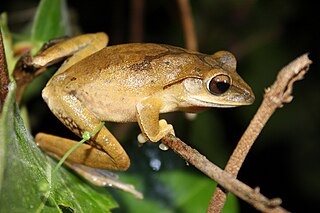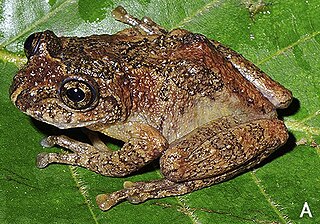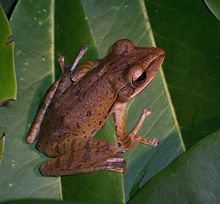
The Rhacophoridae are a family of frogs that occur in tropical sub-Saharan Africa, South India and Sri Lanka, Japan, northeastern India to eastern China, south through the Philippines and Greater Sundas, and Sulawesi. They are commonly known as shrub frogs, or more ambiguously as "moss frogs" or "bush frogs". Some Rhacophoridae are called "tree frogs". Among the most spectacular members of this family are numerous "flying frogs".

The Rhacophorinae are a subfamily of frogs in the family Rhacophoridae. They range from tropical Africa and Asia to temperate China and Japan.

Rhacophorus is a genus of frogs in the shrub frog family (Rhacophoridae)and the related Hylidae make up the true tree frogs. They are found in India, Japan, Madagascar, Africa, and Southeast Asia. Over 40 species are currently recognised.

Polypedates megacephalus, the Hong Kong whipping frog or spot-legged tree frog, is a species in the shrub frog family (Rhacophoridae). In its native range, it is also called "brown tree frog", but this name is otherwise applied to a species of the true tree frog family (Hylidae).

Polypedates colletti is a species of frog in the family Rhacophoridae. It is found in the Malay Peninsula, southern Vietnam, Borneo, Sumatra, and islands of the South China Sea.

Polypedates leucomystax is a species in the shrub frog family Rhacophoridae. It is known under numerous common names, including common tree frog, four-lined tree frog, golden tree frog or striped tree frog. Many past authors have united it with the common Indian tree frog in P. maculatus, but today they are generally considered distinct species. In its native range, it is also called "white-lipped tree frog", but this name is otherwise applied to a species of true tree frogs.

Polypedates macrotis, commonly known as the dark-eared treefrog, sometimes also Bongao tree frog, Bongao bubble-nest frog, Baram whipping frog, or brown-striped tree frog, is a species of frog in the family Rhacophoridae. It is found in the central peninsular Thailand, Sumatra, Borneo, and Sulu Archipelago as well as a range of other Philippine islands.
Polypedates mutus is a species of frog in the family Rhacophoridae. It is found in southern and southwestern China, Myanmar, Laos, Thailand, and Vietnam. However, it may actually represent two different species. It is not known which one of these is the "true" Polypedates mutus as specimens from the type locality in northern Myanmar have not been analysed. Its natural habitats are forests and the surrounding areas. It breeds in standing water. It is suffering from habitat loss.

Rhacophorus lateralis is an endangered rhacophorid tree frog endemic to the Western Ghats in South India. It has several common names: small tree frog, Boulenger's tree frog, small gliding frog, and winged gliding frog. After its original description in 1883 by George Albert Boulenger, the frog was rediscovered in Coorg in 2000 and has since been found in many parts of the Western Ghats around southern Karnataka and northern Kerala. Along with R. malabaricus, it is one of the few anuran amphibians in India that constructs its nest above the ground using leaves.

Minervarya is a genus of frogs in the family Dicroglossidae from south Asia, and Nepal and Bhutan. They are sometimes known as the Cricket frogs or Rice frogs.

Raorchestes is a genus of frogs in the subfamily Rhacophorinae that are found in mountainous regions of South Asia, Southeast Asia, and southern China. A recent study places Raorchestes as a sister taxon of Pseudophilautus. Before the description of the genus in 2010, species now in Raorchestes had been assigned to genera Ixalus, Philautus, and Pseudophilautus.

Ghatixalus is a genus of frogs in the family Rhacophoridae, subfamily Rhacophorinae. They are endemic to the Western Ghats of southern India. They are the sister taxon to a larger clade consisting of Chiromantis, Feihyla, Taruga, Polypedates, and Rhacophorus. The name of the genus combines words "Ghats" and "Ixalus". The former refers to the Western Ghats, and the latter to now-abandoned genus name that lives as the suffix in many generic names for rhacophorid frogs.

Feihyla is a genus of frogs in the family Rhacophoridae, subfamily Rhacophorinae. They are found in southern China and Vietnam, and likely also in Laos. Its phylogenetic position is not yet fully resolved, but it is probably the sister taxon to Taruga, Polypedates, and Rhacophorus. Feihyla was originally erected to resolve polyphyly of Chirixalus by absorbing "Chirixalus palpebralis".

Beddomixalus is a monotypic genus of frogs in the family Rhacophoridae. The only described species, Beddomixalus bijui, is endemic to the Western Ghats, India. Its name is derived from a combination of the cognomen of Richard Henry Beddome, in honour of his work on the amphibian diversity of the Western Ghats, as well as Ixalus, which is often used as a suffix for names of rhacophorid genera.
Polypedates pseudotilophus is a species of frogs in the family Rhacophoridae. It is endemic to Sumatra and Java in Indonesia.
Feihyla inexpectata is a species of frog in the family Rhacophoridae. This recently (2014) described species is endemic to Malaysian Borneo and known from its type locality in the Maliau Basin Conservation Area, Sandakan Division, Sabah and from Danum Valley, also in Sabah. Common name Bornean opposite-fingered tree frog has been coined for it.

Nasutixalus is a genus of frogs in the family Rhacophoridae. The genus is found in northeastern India and adjacent southeastern Tibet as well as western Yunnan (China); the range might extend into the adjacent Nepal and Myanmar. Common name ridged-nose treefrogs has been coined for this genus.

Kurixalus absconditus is a species of frog in the family Rhacophoridae. It is endemic to West Kalimantan, in the Indonesian part of Borneo, and is only known from its type locality near the village of Piasak; it is likely to occur more widely. The specific name absconditus is Latin for "disguised", "concealed", or "hidden", and refers to this species remaining "undetected" within the Kurixalus appendiculatus group. Common name Piasak-frilled swamp treefrog, also spelled Piasak frilled swamp tree frog, has been coined for it.















